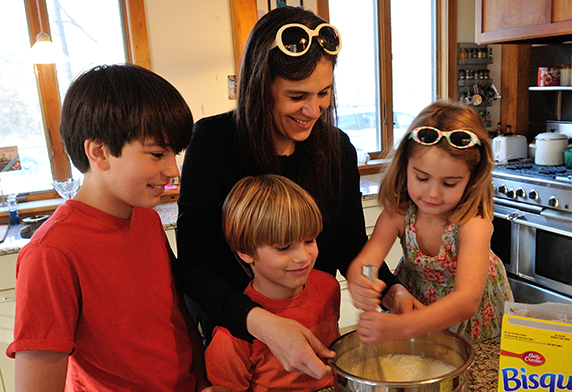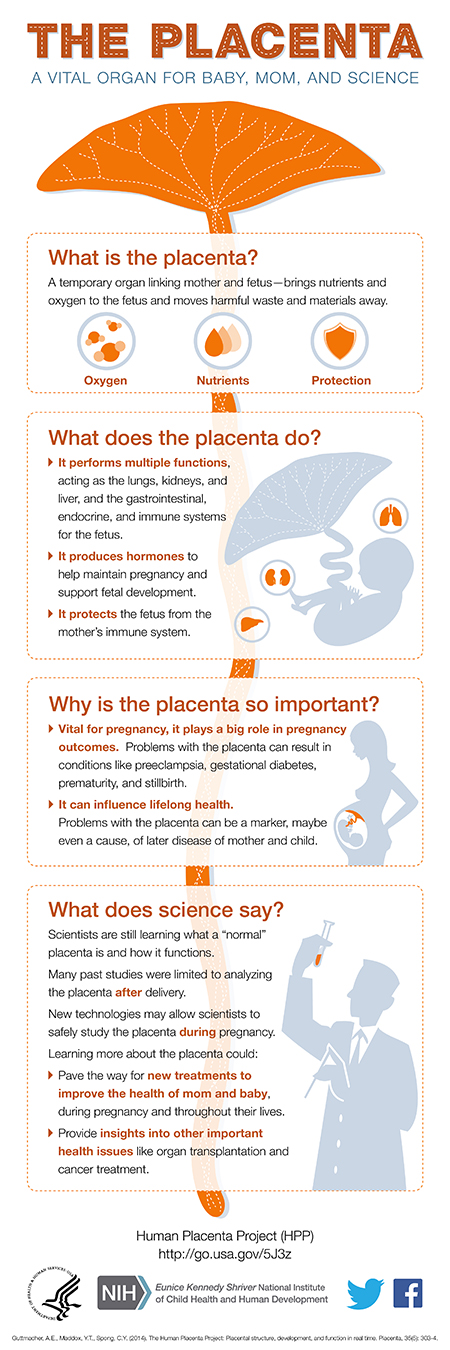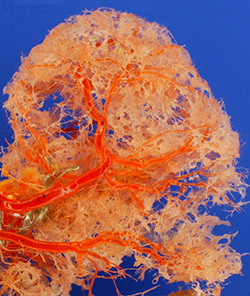The placenta: a mysterious organ
In early winter 2005, Tara Shafer was pregnant with her second child. She was seven months along, her baby safely past the date when doctors assure parents that newborns will survive even if they are born early. Still, Shafer had grown concerned that her baby wasn’t moving enough. She made an appointment with her obstetrician, trying to believe everything was fine. In retrospect, she says, a part of her knew something was very wrong.
 Tara Shafer with her children, Reid (age 12), David (age 8) and Isabelle (age 5). David and Isabelle were born after Shafer received treatment for thrombosis.TARA SHAFER
Tara Shafer with her children, Reid (age 12), David (age 8) and Isabelle (age 5). David and Isabelle were born after Shafer received treatment for thrombosis.TARA SHAFER
Shafer remembers snow falling outside as her doctor broke the news that they couldn’t find a heartbeat. The baby would have to come out. Shafer was afforded little time to process what was happening before labor was induced.
 NATIONAL INSTITUTES OF HEALTH
NATIONAL INSTITUTES OF HEALTH
Shafer’s stillbirth resulted from a placental abruption caused by thrombosis, an undiagnosed blood-clotting disorder that hadn’t presented in her first pregnancy.
The loss of the baby, who was a boy, shattered Shafer. “Your life is never the same,” she says. “No matter how many kids you go on to have, there’s always a piece of you that is devastated by what happened. And you can’t explain how isolating it can be.”
A fetus lost after 24 weeks of pregnancy is considered a stillbirth. About 23,600 pregnancies end in stillbirth every year in the U.S. Miscarriages, defined as fetuses lost before 24 weeks, are thought to occur in 10 percent to 20 percent of pregnancies, though the real number is presumed to be higher since many miscarriages occur before a woman even knows she is pregnant. Researchers believe that problems with the placenta may be behind many of these pregnancy losses. But no one knows for sure.
The human placenta is a temporary organ. Over the course of a pregnancy, it establishes, in a coordinated fashion, critical structures that both protect and grow the fetus. Acting as every organ the fetus needs to survive — heart, lungs, gut, liver, even the endocrine system — the placenta provides all the nutrients, oxygen, water and other molecules necessary for fetal development. The placenta also fends off dangers from the mother, such as viral infections. Once the baby is born, the placenta’s work is done, and it is discarded.
Despite being critical to a baby’s survival, the placenta remains something of a medical mystery. Detailed understanding about how it carries out all its functions is lacking. Even less is known about what has gone awry with those functions when a pregnancy is lost.
The National Institutes of Health established the Human Placenta Project in 2014 to address this lack of knowledge. Researchers funded by the HPP are hoping to create new technologies that will help them investigate how the placenta comes to be, does its job and then closes shop. The project also aims to explore how some disorders, such as heart disease, may arise both for the mother and child later in life if the placenta doesn’t function optimally during pregnancy. The ultimate goal of the HPP is to comprehend better how problems with the placenta may lead to conditions such as preeclampsia, gestational diabetes, fetal growth restriction and stillbirth.
“As clinical and academic as the placenta project seems to be on the face of it, if you dig deeper, it’s incredibly exciting because they’re looking at the reasons that pregnancies fail,” says Shafer, who feels fortunate to have gotten diagnoses for her loss. Shafer is a co-founder of Reconceiving Loss, an online resource for families coping with pregnancy and infant loss. “In looking at those reasons, they are looking to comfort and give answers to women who live decades wondering what happened.”
Why the placenta matters
Even though every human being starts out as a fetus attached to a placenta, placental health often still is portrayed as a women’s issue. The placenta does develop in the uterus but is considered by scientists to be a fetal organ. “It has the same background as the fetus,” says George Saade at the University of Texas Medical Branch in Galveston. “It may be viewed as a foreign organ to the mother."
“I think it’s really important that people in our community, our society and our government funding agencies understand that (placental health) is (a) really critical issue for human development,” says Yoel Sadovsky, an HPP awardee at the University of Pittsburgh. “It’s not just a women’s health issue.”
Typically weighing in at about a pound, a placenta is roughly the size of a small dinner plate. “The placenta is a really fascinating organ to see,” says the HPP’s director, David Weinberg, who is at the Eunice Kennedy Shriver National Institute of Child Health and Human Development. “It’s round. It’s sort of flat. It can be reddish, purplish in color. You can see veins along one surface.”
For its compact size, the placenta carries out a slew of activities. “I would describe it as the most complex, transient, vascular, endocrine, immune human organ that we know the least about,” says Antonio Frias, an HPP awardee at Oregon Health and Science University. “I think it’s amazing that maternal circulation and fetal circulation have to develop in parallel, while at the same time deal with the immunologic issues of a foreign object growing inside (the mother) and enormous endocrine functions to support both fetal growth and maintain maternal health.”
Some of the HPP’s aims
The HPP places much emphasis on the “human” part of its name because animal models are not as useful for studying the placenta as they are for some other organs. There are much greater similarities between mice and humans, explains Sadovsky, when looking at organs such as the heart or the liver than there are when looking at the placenta. Weinberg says that most of the information that we currently have “comes from studying the placenta after delivery, when the game is over.”
With the $46 million that the HPP distributed to researchers for the fiscal year 2015, the central effort of the project is to study the placenta while it does its job over the course of a pregnancy. Weinberg says the project hopes to “either develop completely novel technologies or develop novel applications of existing technologies.”
 A researcher examines a placenta in the lab.NATIONAL INSTITUTES OF HEALTH
A researcher examines a placenta in the lab.NATIONAL INSTITUTES OF HEALTH
The project will sponsor additional research in animal models if the investigators can present a path for eventual translation to humans.
Existing technologies for human research include ultrasound and magnetic resonance technologies that will help researchers observe more clearly and in greater detail how the placenta does its job without interfering with the organ. Frias says his group has been focused primarily on imaging in order to get “better real-time assessments of placental function.” The investigators hope to be able to use these noninvasive tools to gain new understanding of both normal and abnormal placentas.
From a molecular angle, Sadovsky and colleagues discovered microRNAs that are unique to the placenta and may help protect against viral infections that might otherwise cross the placental barrier. However, this discovery was made while looking at cultures of placental cells. Though this new information is significant to placental research, Sadovsky is hoping to be able to look at these types of things in functioning placentas. He says they are also “trying to understand how nutrients are crossing the placenta in normal conditions as well as diseased conditions.”
Connections are important to Alfred Abuhamad of Eastern Virginia Medical School. He is interested in learning more about one of the most important ways the fetus and the mother exchange materials: through blood vessels. Specifically, he says, his group wants to learn how fetal blood vessels form, “how they come together, and how they connect with the maternal blood vessels.”
Investigators also are hoping to learn how the flow of blood between maternal and fetal blood vessels affects the exchange of materials and to connect that information to pregnancy outcome.
Abuhamad has a specific interest in calcium. “Calcium is the sign of aging tissue,” he says, and by studying calcium levels in the first trimester, he and his colleagues hope to help determine if a placenta “has aged before its time.” If so, they may be able to determine that premature labor is correlated with the presence of higher levels of calcium early on in the pregnancy. Furthermore, the research could help unlock some of the answers to what causes other disorders, such as hypertension, which has been correlated with abnormally high levels of calcium.
'We don’t have enough information'
 The chorionic villi of the placenta, shown here, are part of the border between maternal and fetal blood.NATIONAL INSTITUTES OF HEALTH
The chorionic villi of the placenta, shown here, are part of the border between maternal and fetal blood.NATIONAL INSTITUTES OF HEALTH
Weinberg says that the HPP grew out of a search by the leaders at the Eunice Kennedy Shriver National Institute of Child Health and Human Development for the “most promising scientific opportunities for the next decade.” He and his colleagues asked for input on these opportunities from a variety of experts, and the experts repeatedly mentioned the placenta. Besides understanding how a normal placenta functions, the ultimate goal of the HPP is to learn how to avoid the problems that can arise with the placenta, including stillbirths like Shafer’s. This isn’t just about advancing science.
Early on in the project, Weinberg says he received a phone call from a woman who had lost a pregnancy. She was hoping to be able to donate her placenta and help in some way so that other parents wouldn’t have to feel what she had felt.
“In that moment,” Weinberg says, “it really drove home for me that we have an opportunity to do something really important now. If we understood placental development and function across pregnancy better, perhaps we could develop knowledge and insight in technology that would ultimately lead to better pregnancy outcomes and healthier lifelong outcomes for both the mom and child.”
As someone who has gone public with her pain over her lost child, Shafer concurs. “We don’t have enough information. We could have so much more with a coordinated, multipronged medical approach to understanding how (the placenta) develops and when it starts to fail,” she says. “If there are things that could be addressed within that failure, then we could use that information to affect the lives of families in a very important way. For a really wanted baby, the loss is devastating. These babies haunt families.”
Enjoy reading ASBMB Today?
Become a member to receive the print edition four times a year and the digital edition monthly.
Learn moreGet the latest from ASBMB Today
Enter your email address, and we’ll send you a weekly email with recent articles, interviews and more.
Latest in Science
Science highlights or most popular articles

Building the blueprint to block HIV
Wesley Sundquist will present his work on the HIV capsid and revolutionary drug, Lenacapavir, at the ASBMB Annual Meeting, March 7–10, in Maryland.

Gut microbes hijack cancer pathway in high-fat diets
Researchers at the Feinstein Institutes for Medical Research found that a high-fat diet increases ammonia-producing bacteria in the gut microbiome of mice, which in turn disrupts TGF-β signaling and promotes colorectal cancer.

Mapping fentanyl’s cellular footprint
Using a new imaging method, researchers at State University of New York at Buffalo traced fentanyl’s effects inside brain immune cells, revealing how the drug alters lipid droplets, pointing to new paths for addiction diagnostics.

Designing life’s building blocks with AI
Tanja Kortemme, a professor at the University of California, San Francisco, will discuss her research using computational biology to engineer proteins at the 2026 ASBMB Annual Meeting.

Cholesterol as a novel biomarker for Fragile X syndrome
Researchers in Quebec identified lower levels of a brain cholesterol metabolite, 24-hydroxycholesterol, in patients with fragile X syndrome, a finding that could provide a simple blood-based biomarker for understanding and managing the condition.

How lipid metabolism shapes sperm development
Researchers at Hokkaido University identify the enzyme behind a key lipid in sperm development. The findings reveal how seminolipids shape sperm formation and may inform future diagnostics and treatments for male infertility.


